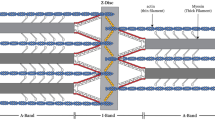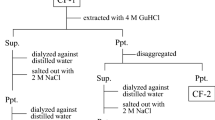Summary
Ultrastructural observations of the immature adhesive disc from tendrils of Boston Ivy showed that the peripheral cells, which are the presumptive contact layer, contain vacuoles of varied sizes which are filled with electron-dense aggregates. In small vacuoles, these deposits were appressed to the tonoplast and fusion of these small vacuoles with the large vacuoles apparently occurs. Cells from the central zone were largely parenchymatous. The vacuoles of many of these parenchyma cells contained electron-dense spheres and hemispheres of material either appressed to the tonoplast or within the vacuole lumen. In these cells, the vacuole-cytoplasm interface was characterized by a filiform network of interconnected membranes. Positive reactions with reagents for the identification of polyphenols indicate that the vacuoles of nearly all the peripheral cells and scattered cells of the central zone contain tanniniferous substances. Insoluble carbohydrates also occur in the vacuoles of the peripheral cells, but they contain little or no protein or lipid.
Similar content being viewed by others
References
Baker, J. R., 1958: Principles of biological microtechnique: A study of fixation and dyeing. New York: John Wiley & Sons, Inc.
Barger, J. D., andE. D. DeLamater, 1948: The use of thionyl chloride in the preparation of Schiff's reagent. Science108, 121–122.
Baur, P. S., andC. H. Walkinshaw, 1974: Fine structure of tannin accumulations in callus cultures ofPinus elliotti (slash pine). Can. J. Bot.52, 615–619.
Beckman, C. H., andW. C. Mueller, 1970: Distribution of phenols in specialized cells of banana root. Phytopathology60, 79–82.
— —, andW. E. MacHardy, 1972: The localization of stored phenols in plant hairs. Physiol. Plant Pathol.2, 69–74.
Bennett, D., andO. Radmiska, 1966: Flotation-fluid staining: Toluidene blue applied to Maraglas sections. Stain Techn.41, 349–350.
Bronner, R., 1975: Simultaneous demonstration of lipids and starch in plant tissues. Stain Techn.50, 1–4.
Byrde, R. J. W., 1963: Natural inhibitors of fungal enzymes and toxins in disease resistance. In: Perspectives of biochemical plant pathology, p. 663 (S. Rich, ed.). New Haven: Conn. Agric. Exp. Sta. Bull.
Chafe, S. C., andD. J. Durzan, 1973: Tannin inclusions in cell suspension cultures of white spruce. Planta113, 251–262.
Craft, C. C., andW. V. Audia, 1962: Phenolic substances associated with wound-barrier formation in vegetables. Bot. Gaz.123, 211–219.
Czaninski, Y., andA. M. Catesson, 1974: Polyphenoloxidases (Plants). In: Electron microscopy of enzymes (M. A. Hayat, ed.) Vol. 2. New York: Van Nostrand Reinhold.
Darwin, C., 1867: On the movements and habits of climbing plants. J. Linn. Soc. Bot.9, 1–118.
Durzan, D. J., S. C. Chafe, andS. M. Lopushanski, 1973: Effects of environmental changes on sugars, tannins, and organized growth in cell suspension cultures of white spruce. Planta113, 241–249.
Esau, K., 1965: Plant anatomy, 2nd Ed. New York-London-Sydney: Wiley and Sons.
Feder, N., andT. P. O'Brien, 1968: Plant microtechnique: Some principles and new methods. Amer. J. Bot.55, 123–142.
Fisher, D. B., 1968: Protein staining of ribboned Epon sections for light microscopy. Histochemie16, 92–96.
Forrest, G. I., 1969: Studies on the polyphenol metabolism of tissue cultures derived from the tea plant (Camellia sinensis L.). Biochem. J.113, 765–772.
—, andD. S. Bendall, 1969: The distribution of polyphenols in the tea plant (Camellia sinensis L.). Biochem. J.113, 741–755.
Gasic, G. J., L. Berwick, andM. Sorrentino, 1968: Positive and negative colloidal iron as cell surface electron stains. Lab. Invest.18, 63–71.
Ginzburg, C., 1967: The relation of tannins to the differentiation of the root tissues inReaumuria palaestina. Bot. Gaz.128, 1–10.
Glass, A. D. M., andJ. Dunlop, 1974: Influence of phenolic acids on ion uptake. IV. Depolarization of membrane potentials. Plant Physiol.54, 855–858.
Goebel, K., 1900: Organography of plants. Oxford: Clarendon Press.
Goldstein, J. L., andT. Swain, 1963: Changes in tannins in ripening fruits. Phytochemistry2, 371–383.
Gyure, W. L., 1973: Colorimetric determination of certain pteridines and purines. Anal. Biochem.51, 421–428.
Haas, P., andT. G. Hill, 1921: The chemistry of plant products. London: Longmans, Green and Co.
Hake, T., 1965: Studies on the reactions of OsO4 and KMnO4 with amino acids, peptides, and proteins. Lab. Invest.14, 470–474.
Hale, C. W., 1946: Histochemical demonstration of acid polysaccharides in animal tissues. Nature157, 802.
Hall, R. H., P. S. Baur, andC. H. Walkinshaw, 1971: Variability in oxygen consumption and cell morphology in slash pine tissue cultures. For. Sci.17, 298–307.
Jaffe, M. J., andA. W. Galston, 1968: The physiology of tendrils. Ann. Rev. Pl. Physiol.19, 417–434.
Karnovsky, M. J., 1971: Use of ferrocyanide-reduced osmium tetroxide in electron microscopy. Abstr. Eleventh Ann. Mtg. Amer. Soc. Cell Biol., New Orleans.
Kosuge, T., 1969: The role of phenolics in host response to infection. Ann. Rev. Phytopath.7, 185–222.
Kuc, J., 1966: Resistance of plants to infectious agents. Ann. Rev. Microbiol.20, 337–370.
Ledbetter, M. C., andK. R. Porter, 1970: Introduction to the fine structure of plant cells. Berlin-Heidelberg-New York: Springer-Verlag.
Lloyd, F. E., 1911 a: The behavior of tannins in persimmons. Plant World14, 1–14.
—, 1911 b: The tannin-colloid complexes in the fruit of the persimmon,Diospryos. Biochem. Bull.1, 7–41.
Mace, M. E., 1963: Histochemical localization of phenols in healthy and diseased banana roots. Physiol. Plant.16, 915–925.
—, andC. R. Howell, 1974: Histochemistry and identification of condensed tannin precursors in roots of cotton seedlings. Can. J. Bot.52, 2423–2426.
Marbach, I., andA. M. Mayer, 1974: Permeability of seed coats to water as related to drying conditions and metabolism of phenolics. Pl. Physiol.54, 817–820.
Martens, P., andN. Pirard, 1943: Les organes glanduleux dePolypodium virginianum L. II. Structure, origine et signification. Cellule49, 383–406.
Mazia, D., P. A. Brewer, andM. Alfert, 1953: The cytochemical staining and measurement of protein with mercuric bromphenol blue. Biol. Bull.104, 57–67.
Millington, W. F., 1966: The tendril ofParthenocissus inserta: determination and development. Amer. J. Bot.53, 74–81.
Moens, P., 1956: Ontogenese des vrilles et differenciation des ampoules adhesives chez quelques vegetaux (Ampelopsis, Bignonia, Glaziovia). Cellule57, 369–401.
Mowry, R. W., 1956: Alcian blue techniques for the histochemical study of acidic carbohydrates. J. Histochem. Cytochem.4, 407.
Mueller, W. C., andC. H. Beckmann, 1974: Ultrastructure of the phenol-storing cells in the roots of banana. Physiol. Plant. Pathol.4, 187–190.
Pearse, A. G. E., 1968: Histochemistry, theoretical and applied. London: J. & A. Churchill.
Peterson, R. L., andL. S. Kott, 1974: The sorus ofPolypodium virginianum: some aspects of the development and structure of paraphyses and sporangia. Can. J. Bot.52, 2283–2288.
Reeve, R. M., 1959: Histological and histochemical changes in developing and ripening peaches. I. The catechol tannins. Amer. J. Bot.46, 210–217.
Reynolds, S. E., 1963: The use of lead citrate at high pH as an electron opaque stain in electron microscopy. J. Cell Biol.17, 208–212.
Ribeareau-Gayon, P., 1972: Plant phenolics. New York: Hafner Publishing Co.
Ruddell, C. L., 1967: Epoxy media for 1–2 micron sectioning. Stain Techn.42, 253–255.
Spurr, A. R., 1969: A low viscosity epoxy resin embedding medium for electron microscopy. J. Ultrastruct. Res.26, 31–42.
Swain, T., 1965: The tannins. In: Plant biochemistry (J. Bonner, andJ. E. Varner, eds.). New York-London: Academic Press.
Tucker, S. C., andL. L. Hoefert, 1968: Ontogeny of the tendril inVitis vinifera. Amer. J. Bot.55, 1110–1119.
von Lengenkern, A., 1885: Die Bildung der Haftballen an den Ranken einiger Arten der GattungAmpelopsis. Bot. Zeit.43, 337–346.
Author information
Authors and Affiliations
Rights and permissions
About this article
Cite this article
Endress, A.G., Thomson, W.W. Ultrastructural and cytochemical studies on the developing adhesive disc of Boston Ivy tendrils. Protoplasma 88, 315–331 (1976). https://doi.org/10.1007/BF01283255
Received:
Revised:
Published:
Issue Date:
DOI: https://doi.org/10.1007/BF01283255




